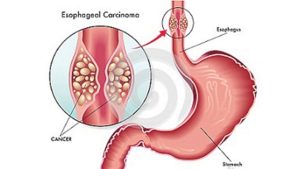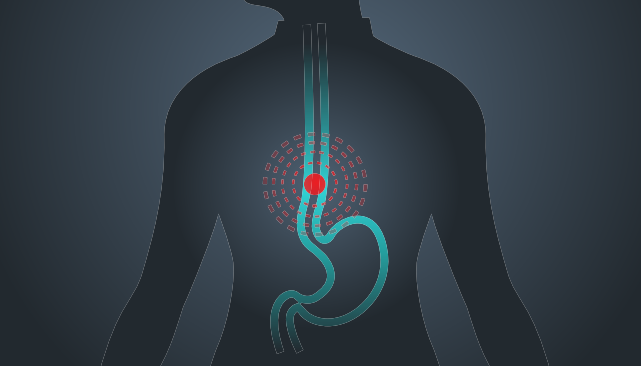Introduction
Esophageal cancer, a formidable adversary, emerges when abnormal cells begin proliferating in the esophagus—a crucial tube connecting the throat to the stomach. This condition, often discovered at advanced stages, merits our understanding as we delve into its nuances, encompassing causes, symptoms, and diverse treatment options.
Types of Esophageal Cancer
Two primary variants characterize esophageal cancer, each with distinct characteristics:
- Squamous Cell Carcinoma: This type originates in the squamous cells lining the inner esophagus. It has the potential to affect the entire length of the esophagus.
- Adenocarcinoma: Emerging from gland cells, adenocarcinoma typically develops in the lower esophagus near the stomach. Acid exposure to this region is a known contributing factor.

Recognizing Symptoms
Esophageal cancer often conceals itself in the early stages, presenting no discernible symptoms. However, as it progresses, individuals may experience:
- Difficulty or Painful Swallowing: A notable early sign, as the cancer affects the esophagus’s functionality.
- Weight Loss: Unexplained weight loss may occur due to altered eating habits.
- Chest Pain: Discomfort or pain behind the breastbone may manifest.
- Coughing and Hoarseness: Persistent coughing and hoarseness could signal advanced stages.
- Indigestion and Heartburn: Chronic indigestion and heartburn may be indicative of esophageal issues.
Understanding Risk Factors
Several factors elevate the risk of developing esophageal cancer:
- Tobacco Use: Smoking or other tobacco-related activities heighten susceptibility.
- Alcohol Consumption: Heavy alcohol use is a recognized risk factor.
- GERD (Gastroesophageal Reflux Disease): Chronic reflux, where stomach contents flow back into the esophagus, increases the risk.
- Barrett’s Esophagus: A condition linked to GERD, it involves changes in esophageal cells, elevating the risk of adenocarcinoma.
- Demographic Factors: Men, the elderly, and individuals who are obese face a higher risk.
Diagnostic Process
Diagnosing esophageal cancer is a meticulous process involving various assessments:
- Clinical Evaluation: Your doctor reviews symptoms, medical history, and conducts a physical examination.
- Imaging Tests: Barium swallow X-ray and endoscopy provide visual insights into the esophagus.
- Biopsy: During endoscopy, tissue samples are collected and examined for cancer presence.
- Staging Tests: Computed tomography (CT) scans, positron emission tomography (PET) scans, thoracoscopy, and laparoscopy help determine the cancer’s extent.
Grasping Esophageal Cancer Stages
Esophageal cancer staging, denoted by Roman numerals (I to IV), offers a roadmap for treatment decisions:
- Stage 0: Abnormal cells confined to the inner layer of the esophagus.
- Stage I: Cancer limited to the esophageal cell layer.
- Stage II: Cancer reaches the muscle layer or outer esophageal wall, potentially involving nearby lymph nodes.
- Stage III: Deeper infiltration into inner muscle or connective tissue, potential organ involvement, and increased lymph node spread.
- Stage IV: Advanced stage with distant organ spread.
Staging employs tests like chest X-rays, bronchoscopy, CT scans, endoscopic ultrasound, thoracoscopy, and laparoscopy.
Treatment Modalities
Effective esophageal cancer treatment hinges on early detection and considering individual health factors. Options include:
- Surgery: Removal of part or the entire esophagus.
- Radiation Therapy: Targeting cancer cells with focused radiation.
- Chemotherapy: Potent drugs combating cancer cells, often combined with radiation or surgery.
- Targeted Therapy: Precision treatments targeting specific cancer aspects to impede growth.
- Immunotherapy: Boosting the immune system to attack cancer cells.
- Specialized Interventions: Techniques like photodynamic therapy, electrocoagulation, cryotherapy, and endoscopic mucosal resection cater to specific cases.

Clinical Trials
Participation in clinical trials, where new treatments are tested, holds promise for groundbreaking advancements. The outcomes influence potential approvals by regulatory bodies, contributing to the evolution of esophageal cancer care.
Tailored Treatment Approaches by Stage
The approach to esophageal cancer treatment varies based on the cancer’s stage:
- Stage 0: Surgical interventions or therapies like photodynamic therapy, radiofrequency ablation, or endoscopic mucosal resection.
- Stages I, II, III: A combination of surgery, chemotherapy, and radiation.
- Stage IV: Focused on palliative therapy, aiming to alleviate pain and difficulty swallowing. Involves chemotherapy, radiation, targeted therapy, and immunotherapy. want to know other health issues
Survival Rates
Understanding the prognosis is crucial. As per the American Cancer Society, five-year survival rates for esophageal cancer are 47% for localized cancer, 25% for regional spread, and 5% for distant metastasis, considering other potential causes of death.
Conclusion
Esophageal cancer’s subtle progression necessitates heightened awareness. Early detection, coupled with informed treatment choices, significantly influences outcomes. Regular screenings, lifestyle modifications, and a proactive approach to symptoms contribute to the ongoing battle against this formidable adversary.










